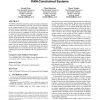Free Online Productivity Tools
i2Speak
i2Symbol
i2OCR
iTex2Img
iWeb2Print
iWeb2Shot
i2Type
iPdf2Split
iPdf2Merge
i2Bopomofo
i2Arabic
i2Style
i2Image
i2PDF
iLatex2Rtf
Sci2ools
EMSOFT
2009
Springer
2009
Springer
NANDFS: a flexible flash file system for RAM-constrained systems
NANDFS is a flash file system that exposes a memory-performance tradeoff to system integrators. The file system can be configured to use a large amount of RAM, in which case it delivers excellent performance. In particular, when NANDFS is configured with the same amount of RAM that YAFFS2 uses, the performance of the two file systems is comparable (YAFFS2 is a file system that is widely used in embedded Linux and other embedded environments). But YAFFS2 and other state-of-the-art flash file systems allocate RAM dynamically and do not provide the system builder with a way to limit the amount of memory that they allocate. NANDFS, on the other hand, allows the system builder to configure it to use a specific amount of RAM. The performance of NANDFS degrades when the amount of RAM it uses shrinks, but the degradation is graceful, not catastrophic. NANDFS is able to provide this flexibility thanks to a novel data structure that combines a coarsegrained logical-to-physical mappi...
EMSOFT 2009 | Log-structured file System | Software Engineering | Systems Allocate Ram | file System |
| Added | 26 May 2010 |
| Updated | 26 May 2010 |
| Type | Conference |
| Year | 2009 |
| Where | EMSOFT |
| Authors | Aviad Zuck, Ohad Barzilay, Sivan Toledo |
Comments (0)

